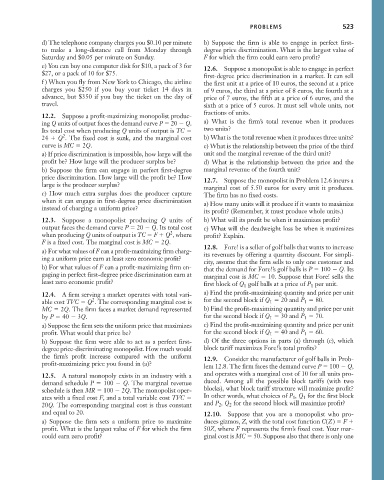Page 549 - Microeconomics, Fourth Edition
P. 549
c12capturingsurplus.qxd 7/22/10 10:41 AM Page 523
PROBLEMS 523
d) The telephone company charges you $0.10 per minute b) Suppose the firm is able to engage in perfect first-
to make a long-distance call from Monday through degree price discrimination. What is the largest value of
Saturday and $0.05 per minute on Sunday. F for which the firm could earn zero profit?
e) You can buy one computer disk for $10, a pack of 3 for 12.6. Suppose a monopolist is able to engage in perfect
$27, or a pack of 10 for $75. first-degree price discrimination in a market. It can sell
f ) When you fly from New York to Chicago, the airline the first unit at a price of 10 euros, the second at a price
charges you $250 if you buy your ticket 14 days in of 9 euros, the third at a price of 8 euros, the fourth at a
advance, but $350 if you buy the ticket on the day of price of 7 euros, the fifth at a price of 6 euros, and the
travel. sixth at a price of 5 euros. It must sell whole units, not
fractions of units.
12.2. Suppose a profit-maximizing monopolist produc-
ing Q units of output faces the demand curve P 20 Q. a) What is the firm’s total revenue when it produces
Its total cost when producing Q units of output is TC two units?
2
24 Q . The fixed cost is sunk, and the marginal cost b) What is the total revenue when it produces three units?
curve is MC 2Q. c) What is the relationship between the price of the third
a) If price discrimination is impossible, how large will the unit and the marginal revenue of the third unit?
profit be? How large will the producer surplus be? d) What is the relationship between the price and the
b) Suppose the firm can engage in perfect first-degree marginal revenue of the fourth unit?
price discrimination. How large will the profit be? How 12.7. Suppose the monopolist in Problem 12.6 incurs a
large is the producer surplus?
marginal cost of 5.50 euros for every unit it produces.
c) How much extra surplus does the producer capture The firm has no fixed costs.
when it can engage in first-degree price discrimination a) How many units will it produce if it wants to maximize
instead of charging a uniform price?
its profit? (Remember, it must produce whole units.)
12.3. Suppose a monopolist producing Q units of b) What will its profit be when it maximizes profit?
output faces the demand curve P 20 Q. Its total cost c) What will the deadweight loss be when it maximizes
2
when producing Q units of output is TC F Q , where profit? Explain.
F is a fixed cost. The marginal cost is MC 2Q.
12.8. Fore! is a seller of golf balls that wants to increase
a) For what values of F can a profit-maximizing firm charg- its revenues by offering a quantity discount. For simpli-
ing a uniform price earn at least zero economic profit?
city, assume that the firm sells to only one customer and
b) For what values of F can a profit-maximizing firm en- that the demand for Fore!’s golf balls is P 100 Q. Its
gaging in perfect first-degree price discrimination earn at marginal cost is MC 10. Suppose that Fore! sells the
least zero economic profit? first block of Q 1 golf balls at a price of P 1 per unit.
12.4. A firm serving a market operates with total vari- a) Find the profit-maximizing quantity and price per unit
2
able cost TVC Q . The corresponding marginal cost is for the second block if Q 1 20 and P 1 80.
MC 2Q. The firm faces a market demand represented b) Find the profit-maximizing quantity and price per unit
by P 40 3Q. for the second block if Q 1 30 and P 1 70.
a) Suppose the firm sets the uniform price that maximizes c) Find the profit-maximizing quantity and price per unit
profit. What would that price be? for the second block if Q 1 40 and P 1 60.
b) Suppose the firm were able to act as a perfect first- d) Of the three options in parts (a) through (c), which
degree price-discriminating monopolist. How much would block tariff maximizes Fore!’s total profits?
the firm’s profit increase compared with the uniform 12.9. Consider the manufacturer of golf balls in Prob-
profit-maximizing price you found in (a)? lem 12.8. The firm faces the demand curve P 100 Q,
12.5. A natural monopoly exists in an industry with a and operates with a marginal cost of 10 for all units pro-
demand schedule P 100 Q. The marginal revenue duced. Among all the possible block tariffs (with two
schedule is then MR 100 2Q. The monopolist oper- blocks), what block tariff structure will maximize profit?
ates with a fixed cost F, and a total variable cost TVC In other words, what choices of P 1 , Q 1 for the first block
20Q. The corresponding marginal cost is thus constant and P 2 , Q 2 for the second block will maximize profit?
and equal to 20. 12.10. Suppose that you are a monopolist who pro-
a) Suppose the firm sets a uniform price to maximize duces gizmos, Z, with the total cost function C(Z) F
profit. What is the largest value of F for which the firm 50Z, where F represents the firm’s fixed cost. Your mar-
could earn zero profit? ginal cost is MC 50. Suppose also that there is only one

